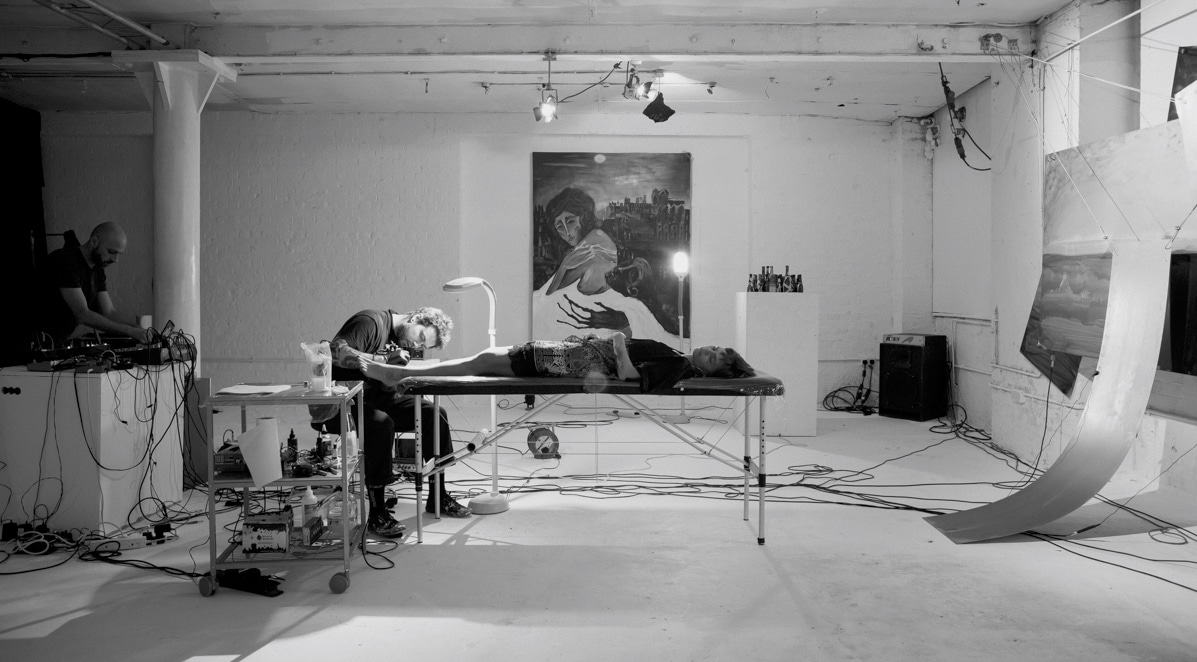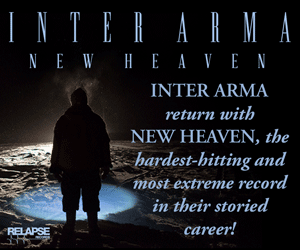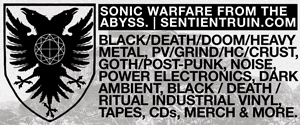Body of Reverbs is an installation that unites sound and tattoos in one vibrant experience. The practice is research on the connection between space, body and sound. The tattoo machine is a real musical instrument that translates the vibrations of the needle on the skin into a sound. The pain felt during the performance is amplified through the space and the result is unreal. Servadio, an Italian artist and tattooer based in London, is the mind behind this project. I talked with him about Body of Reverbs, his art and how important it is to revaluate permanent body modifications practices like tattooing that have become, in the last years, mass-marketed products.
Marika Z.: Tell us more about Body of Reverbs..
Servadio: Body of Reverbs is a post-tattoo practice. It’s research that I’m carrying out on the practice of tattoos. It creates a ritual in which the sound of the tattoo machine is amplified, creating a connection between the pain you feel and the actual sound vibration you’re hearing. The vibration of your body through the space and back into your ear forms a unique cycle. This is mainly how we work. I use a tattoo machine as an actual sound instrument, and there’s a sound engineer, or a musician, that takes the vibration of my machine and amplifies and modifies it through synthesizers or whatever pedal. It’s free improvisation between me and someone else on someone’s body. That’s why the actual graphic result, or the look of the tattoo, is completely abstract, because I’m literally playing on them. I’m not looking at it. I’m mainly hearing and working an experience out, rather than creating the craft of a tattoo.
When did you start thinking about this project? What was the creation process like?
Well, my friend, Mattia Portello, and I are really into experimental music. His name is VeRa Spektor. He works on the spectrum of industrial, power electronics, ambient and that kind of stuff. We have a little collective called Workin’ Klass Noize. One day I was just coming back from the tattoo shop and I stopped by because we wanted to play some tunes. I had my tattoo machine and as a joke we started fucking around a bit with the machine, and suddenly I opened a new door and thought, “Woah, this is really interesting!” That was in 2014. It started as studio experimentation and then in 2015 Paula Delgado joined the project and we did the first public performance, which was in Hackney Wick, and then from there, everything evolved into actual research in tattooing and sound.
Body of Reverbs connects the art of tattoo with sound. How are these two aspects related?
Pain and sound are both very powerful mnemonic tools. They imprint memories and feelings, and work on a mnemonic level. If you take tattooing and ask what is missing nowadays, the answer is the ritualistic aspect. There was a need to bring ritual, the original stuff, back to tattooing. And we wanted to do that in a very contemporary way: by using technology and electronic sounds. We brought ritual back to music and to tattoo and then brought them both together in a way that forms a contemporary ritual.
During the performance, the sound of your tattoo machine is captured by a sound artist. How does it work?
Technically speaking, with a contact microphone. So, a piezoelectric disk is mounted on the actual machine. Sometimes it’s one, sometimes two, it depends. I like to create different machines for different sounds. I choose the right machine for the right ritual, based on the sound that the specific machine can create, and then I use these microphones that don’t record sound. If you speak into it, they won’t register anything, they just collect vibrations. If I place one here on the table and then hit the table, I can amplify the sound. And it’s the same for a tattoo machine. So there’s a cable from my machine to whoever I’m playing with. I often play with Alberto Brunello, who plays as Hexn. I really like the way he works because he’s got a ritualistic aspect to his own projects. We’re good friends also, so that works very well. He knows what I need during the performance and we understand each other very well on a very deep level. So, it’s good to work with him. But I also collaborate with many other artists. My machine is literally talking to all their instruments, and they take the sound and reshape it. And I’m on the other side, listening to it and following back. It’s like a circle, a free improvisation, a jam session. And meanwhile there is someone sitting there in pain.
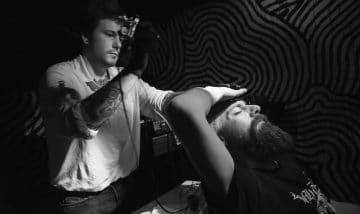
Do you think this relationship between art and music represents two aspects of your career as an artist?
I used to play with a few bands but I stopped because tattooing and art taking too much of my time. I stopped being in proper bands but I’ve always been connected to sound. It used to be music, but then when I’ve got into experimental music everything turned into sound. So now I like to say I work with sound. It’s a very important aspect that I want to develop more and more. But yes, I come from a musical background and an art background, all mixed together. Often in life though you have to choose which path you want to take, so at some point I was just tattooing. And once I sorted that out and it was working I could start reaching out to other things. Now I’m very happy because I’ve been able to take back the sound aspect that I had lost for many years.
Professionally, you were born as a painter and then you became a tattoo artist. What happened?
Well, I studied art in Italy. And drawing is the only thing I know how to do. Naturally, my main interest was drawing, painting, illustration, graffiti or doing covers for punk bands and the like. So that’s where I come from. In a very general way, you come into contact with the world of tattooing because your friends are getting tattooed and it’s just part of the culture. I’ve always been fascinated by it and one day I just took a tattoo machine and I tattooed myself. My friend taught me how to set it up more or less, and I tattooed myself. And I said, “Woah! Hey! This is cool!” So I just kept on tattooing myself and suddenly you do a couple of friends and then people are coming to you because they know your illustrations and ask for things.
Do you remember your first tattoo?
Yeah, it’s a jaw on my leg.
What’s the link between painting on paper or canvas and drawing on skin? Is there a difference?
Yeah, there’s a huge difference. A canvas doesn’t talk to you and it’s completely passive, so you can really work out all your ego and stuff on a canvas, which is a beautiful thing because you can really create a statement about something. And that thing is really going to last forever. We always think that tattoos last forever, but they don’t. They last as long as you live, which is not much. If you think about it on a larger scale, we are nothing and we live, what? A hundred years, let’s say. So a tattoo doesn’t live long. It lives with you – in the span of your own life it lasts forever. It’s your own personal forever, which is beautiful, but it’s not someone else’s forever. So that’s the difference. A canvas is for the world and you’re thinking that you’re doing something that could resonate through maybe hundreds and hundreds of years. It could resonate for thousands of years. Look at the cave paintings, they’re still there.
So which do you prefer then? Tattooing or the longevity of the painting?
I like them both and I need both. I need print making, I need painting, I need tattooing. They’re all different activities, but I need them all. I don’t think I could be just a painter, just a tattoo artist, just a print maker or just a performer. To me they’re all part of the same universe. What connects all these things is that I’m trying to express what I have in my head, or a few concepts related to a person and the environment in which they’re living. Maybe that’s why I do a lot of figures and landscapes. But they’re all part of the same thing. Then, I decide to treat things differently depending on whether I’m working on someone’s body, a canvas or print.
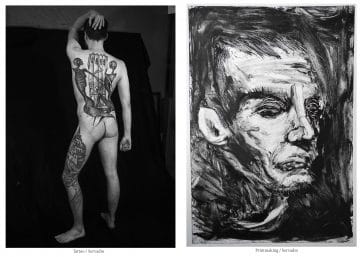
Your subjects include portraits of sad women, skulls, windows and flowers. Where does your inspiration come from?
I’m really influenced by where I live. So now I live in an old, industrial area that’s full of life, but it’s a melancholic place that they’re destroying. I find this really inspiring. And then I come from a really fucked up place in the countryside and it’s all flat, there’s nothing to do. And then I really like paintings from the 20th century. I guess it’s a big mix between where I live, and what I experience. I elaborate on it and bring it out. And then there’s a bit of what I like, the current times, what my friends are doing. We’re all living the vibe of what is going on, so we influence each other a lot. I’m influenced by a lot of friends of mine. And the kind of art that I like. I grew up with a lot of expressionism.
Is expressionism the art movement that interests you most?
I think so. It’s the way I learned how to draw. I felt a personal connection with it. Then I discovered graffiti and punk and then everything got groovy. After a while I thought, OK, maybe that’s not me so much. So you take all these experiences and the result is what you’re doing now.
Recently, tattooing has become a sort of mass marketed product. Is Body of Reverbs an attempt to return to the birth of it as an art?
Yes, that is exactly what it is. In the same way you can go to a shop and buy a tattoo by someone who doesn’t give a fuck about you. You just buy it like you would at a super market. I love tattoo shops, but that’s not really my background. I never really did an apprenticeship, and I learned tattooing in squats. It was always a very underground environment and there was no money around, and you weren’t getting paid. It was like, if you want to do it, you have to do it because you really love it. But now I work in shops and everything is way more mainstream and institutionalized. But in a way, I try, and I want and I hope that I’m keeping it true, within my regular tattoo activity. Body of Reverbs is the research side that I’m doing, it’s an experiment that I’m working on. It is exactly an attempt to put dynamite in the foundations of the structure of tattooing to create a new ritual that doesn’t necessarily involve a tattoo shop, and can be done wherever you want. Up in the Alps, in the forest or wherever.
As a tattoo artist, what’s the connection between you and your costumer? Or the person you tattoo.
It depends. Sometimes there is a really striking connection and you can feel the sparks. Sometimes the process is a bit slower, and more reflective. Every customer is different. The way I work is usually that I never really draw anything in particular before the appointment. I’ve got to see the person and we see what we can do. We kind of decide on it together and everything is very spontaneous. And I want to keep it spontaneous. I wouldn’t like to send a drawing via email. I don’t believe in that. So the connection between the client and myself is very spontaneous. I usually draw things in the moment, sometimes directly on the person with a marker.
And during Body of Reverbs?
During Body of Reverbs it’s way deeper. You’re there to give them an experience, not a cool design. I’m really into the designs that I’m doing as another part of my research, as another way, as a classic way. But in Body of Reverbs the subject is abstract. It’s literally a scribble, usually. Sometimes I’ve done some tattoos on subjects, but that was more related to the place and to the installation.
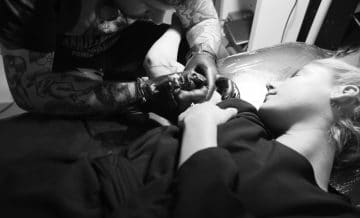
Pain is one of the principal aspects of Body of Reverbs. Can you tell you us about the experience of someone who has participated in the performance?
We’ve had different feedback and outcomes. Mainly, they stay within two different kinds. The first is feeling that the whole experience of tattooing is amplified. The pain was terrible because the sound was terrible. Others have said the pain got cancelled out almost, because the sound was really loud and everything becomes like a unique bubble of feelings. The sound is so loud, and you’re receiving the vibration through the sound, as well as the vibration from the tattoo machine and the pain, and it’s all the same. We take it as a ritual. We start, we lie the person down and then suddenly everything starts to come up and we follow them through the process of it.
And what do you feel?
I feel like a magician, a healer, a shaman. I was talking to the guys from Phurpa (the band), and they were saying, “Oh, we’re not shamans! This is not shamanic music! This is magic music!” I said, “What’s the difference?” But that’s the thing. There’s one point that I’m missing. I don’t have any background in spiritual or ritualistic whatever. What I’m doing is a ritual that works in our society because we don’t have any spirituality. The tattoo is one of the last things we still have that is handmade and you can get from a person and makes you feel pain and is going to stay with you all your life. It’s a beautiful thing we’re ruining. I’m not a priest, I don’t have any knowledge. But I want to take it in that way. I want to create something out of a necessity. So I don’t know if I’m a magician or a priest or a healer. I think I feel like a healer because you get fucking redeemed through pain. I don’t know, I guess people seem happy afterwards, and not because of what they got in terms of design. They’re happy about what they got as an experience. So for me, that’s enough. To me, that means it’s working.
Body of Reverbs was born in Hackney Wick, a neighborhood of London. Why there?
Body of Reverbs started there because that’s where I have my studio. What you’ve seen in the video (at the end of this article) is strictly related to that area. You can do Body of Reverbs in different places and environments and it is always related to that environment. We’ve done it in the woods, at a festival, in a club, a tattoo shop, an abandoned place, a squat, a fetish club, the mountains. It’s different everywhere you do it because it relates to the place. The video is dedicated to Hackney Wick. We had a big installation with metal sheets that were literally vibrating with the same frequency of the machine. We put cork speakers behind them so they were shaking. The whole room was shaking. We had broken glass and sheets of steel and all of that.
You are from Italy but you have been living in London for 10 years. What is your connection to the city?
London is love and hate. London is a very powerful environment. And it sucks you to death. I chose to end up there. We were living in Venice and we decided to leave – we needed to get out of Italy somehow. We knew some friends living in squats in London and we thought we’d go see them. I brought my bike and my backpack and everything I could, and it’s now been seven or eight years. But it’s got a strong energy and I’ve got a really good crew of friends that I really love and that are really inspiring. So I want to live there. Sometimes it’s a real struggle, I often think of moving, of leaving, of going to a quieter environment. But then I miss it straightaway and I go back. So that’s the deal. Luckily, I’m away from London enough to appreciate it when I go back. In the last six months I spent three weeks in London I guess. The rest of the time I was moving around Europe like a pinball, doing different projects between Body of Reverbs and exhibitions or a tattoo guest, I’ve been around enough.
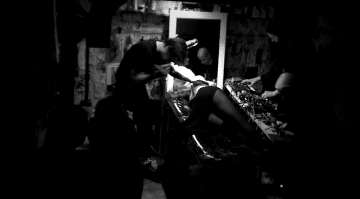
And how does the environment influence your art? When you are in London do you draw differently?
Yeah, I think so. Because you perceive the environment. That actually changes the way you are and your perception. So if the outcome is related to your feelings, if you’re an expressionist, then you reveal what’s going on inside. That’s how I understood I was an expressionist. I have that approach because I get influenced by the people I stay with, by the environment I’m living in, by the place where I am. If I were to move to a different place, I would stop drawing what I’m drawing. Many years ago, when I lived in the countryside and worked in Italy, I worked at funerals. Everyday, I carried coffins with dead people inside and I wore a suit. I was tattooing also, a tomb for example. But that was my day job, to pay for my things, and that was my environment. So in the daytime I was in a little church in the countryside and at the cemetery, bringing dead people here and there, and then I would go back and spend the night with my friends, drinking beer and tattooing burning churches and deviled with hard-ons. That was my environment. When I moved to London, I was still into all that for many years because it was a really strong influence. That was me, you know, I come from the countryside where it’s all folksy shit and really Catholic, so I was tattooing lots of weird Catholic stuff for many years. That was one part of my production. Then I changed because all of that stopped. London came in and that environment filled me – the melancholy and sadness of the struggle of man in a big city. If I ever go to the Sahara to live maybe I what I draw would change.
Are you planning to repeat Body of Reverbs someday?
Yeah, at some point, as soon as I have a chance. Next year, we’ll probably do a bigger installation that will involve photography and different media as well.
Do you know where?
Not yet, maybe in Rome. We’ll see. But coming up soon, at the end of July, we’re doing a night in the basement of a tattoo shop in Belluno (Italy). It’s a shop called Nord Tattooing and they do these events called Nord Basement. They do some experimental music events in the basement of the actual tattoo shop and I thought, “Fuck, that’s perfect!” I’ll go there and tattoo for a few days and just move in downstairs to do some rituals. So we’ll be there on 20 July, and on 22 July we’ll be performing near Pavia (Italy) at Rock Valley Fest.
(Video: Alessandro Dordoni)
(Photos: Giacomo Streliotto)

